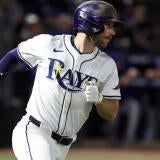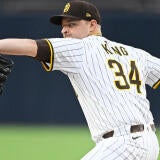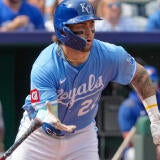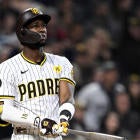Fantasy Baseball: Jurickson Profar, Reynaldo Lopez headline second-half's biggest bust candidates
Also, why now is the perfect sell-high opportunity for Brent Rooker

We talked about second-half sleepers and second-half breakouts for Fantasy Baseball already this week, and now it's time to take a decidedly more negative outlook: Let's talk second-half bust candidates.
One quick note here: It's a lot harder to find second-half bust candidates among hitters than pitchers right now, because there just aren't many hitters who seem to be obviously above their heads right now. To take one example: Matt Chapman is a top-75 overall player in Roto and a top-eight third baseman, and I certainly don't expect him to be anywhere that valuable the rest of the way.
But Chapman is also hitting just .241/.322/.423, so I'm not sure me calling him a "bust" really helps anyone. He somehow has eight steals and is on a 100-plus run pace despite hitting primarily fourth in a mediocre offense with a .322 OBP. I don't expect his stolen base or run pace to sustain, but I also don't think Chapman's production otherwise is unsustainable in any way.
It's a lot easier to find unsustainable pitching production these days, in other words. So, while I focused on making picks for every position in my second-half sleepers and breakouts lists, for busts, I'm going with an even split of pitchers and hitters for the busts. And the pitcher list could have been twice as long.
Jurickson Profar, OF, Padres
We've been screaming "he can't keep getting away with this" about Profar for months, so maybe it's time to just buy into it. But the improvements he's made in his age-31 season are pretty unprecedented. This isn't a guy slightly tweaking his launch angle to unlock more in-game power or something – this is a guy going from mediocre-at-best quality of contact metrics for close to a decade to putting together by far the best batted-ball data of his career at a point where a player's physical skills are supposed to be in decline.
How much of an outlier is what we're seeing from Profar? Well, he's gone from an 86.5 mph average exit velocity last season (85.3 the year before) to 90.9 mph this season – without any kind of increase in his max exit velocity to suggest a significant change in his underlying raw power. That 4.4 mph jump in average exit velocity isn't exactly unprecedented in the Statcast era, but it's pretty close – only five qualifiers have increased their average EV by more than 4 mph, out of 787 player seasons in the sample. Among those five, only Joey Votto in 2021 was older than 27 years old when he managed it, and his prior season came in 2020, which was a much smaller sample size.
So, yeah, there's basically no precedent for a player of Profar's age pulling this trick off. That doesn't mean it's not sustainable, of course, but as a general rule, you should probably bet against outliers, and Profar is a pretty significant one right now. I know I've been wrong about Profar all season so far, so if you are inclined to dismiss my concerns, I get it. But I think the likeliest outcome is Profar's first half ends up being by far better than his second.
Brent Rooker, OF, Athletics
For Rooker, here's what it comes down to: How real is his improvement against breaking balls? He crushed fastballs last season to the tune of a .396 expected wOBA, and he made enough contact against them that it was probably a mistake to throw him something hard, especially with a whiff rate over 50% and an xwOBA below .275 against both breaking balls and offspeed pitches. So far in 2024, Rooker is still rather hopeless against offspeed pitches (.222 xwOBA, 44% whiff rate), and he's still out there flailing at breaking balls a bit too often, with a 46.1% whiff rate. But the biggest change in his skills from 2023 to 2024 comes when he does manage to make contact against a breaking ball, with his xwOBA jumping from .267 to .382.
This is a guy who has gone from hitting .246 last season to .282 despite an identical strikeout rate, and it mostly comes from better results on balls in play against breaking balls. The power is real, but the power has always been real, and he's still managed to hit below .230 in two of three full months this season. Rooker is red hot right now, going 13 for 26 in the month of July so far, which might make this the perfect time to try to sell high.
Anthony Volpe, SS, Yankees
On the flip side, this is exactly the wrong time to try to trade Volpe, who has an OPS of just .509 since the start of June. The problem is, I'm not sure this is just a bad stretch – he might just be a legitimately bad hitter at this point in his MLB career.
There was a lot of optimism around Volpe and his reworked swing back in April, especially when he opened the season with an OPS north of 1.000 in the first 15 games of the season. But the underlying skill set never really backed it up, and he's put up an expected wOBA below .300 since the start of May. His Fantasy value still held pretty steady when he was consistently batting leadoff, but that hasn't been the case for the past week, and it's hard to see what the case for Volpe as even a starting-caliber player is at this point. Stolen bases are easier to find than ever, and his .249 expected batting average with little power gives little to be optimistic about. He's still young enough to turn things around, but it's going to require significant improvement of the underlying skill set. And I'm just not seeing it.
Ceddanne Rafaela, OF, Red Sox
Rafaela is one player who the underlying stats really don't believe in. He has a .226 expected batting average and .271 xwOBA, mostly because of his miserable plate discipline, but also because the quality of contact he produces just isn't particularly impressive. Despite that, Rafaela is hitting .312/.339/.492 since the start of June, which just feels like the most unsustainable production of any player in baseball right now. Rafaela has a .410 BABIP in that stretch and is still hitting ninth every day for the Red Sox, so this one feels like a pretty easy fade. There's power and speed here, but not difference-making in either regard and coupled with what will likely be a pretty bad batting average, I think he's just a low-end option for categories leagues. You'd be smart to try to trade him right now.
Connor Wong, C, Red Sox
Wong has been a solid stabilizer at the catcher position, with his four steals and .309 average especially helpful in categories leagues. The bar at catcher remains awfully low, so if you wanted to argue that Wong should be able to clear that as a No. 2 option, that's reasonable enough. But this is another one where he is clearly overperforming his underlying skill set, with a .354 wOBA compared to a .308 xwOBA. Wong's 38.9% pull rate is below average, so we can't even point to that as a reason he should be able to outrun those stats, and his massive 17.9% infield fly ball rate should serve as a drag on both his average and power. Wong has done a good job of cutting his strikeout rate from last year, but he's also had to sacrifice quality of contact to do it, which makes it pretty easy to expect worse production moving forward.
Chris Sale, SP, Braves
Alright, this is one I'm scared of. Sale has been terrific, and there's basically nothing in the underlying numbers to suggest it's a fluke – his slider is playing about as well as it ever has, and he's generating tones of weak contact with his entire arsenal. His 2.64 xERA is the third-best mark in baseball, behind only Garrett Crochet (innings limits) and Tyler Glasnow (currently injured). You can make a pretty compelling case that Sale is the best pitcher in Fantasy right now.
This isn't about projecting regression for Sale, though I could see that, certainly – let's not forget, he had a 4.30 ERA last season in basically an identical sample to his current season success. For me, the case for Sale as a sell-high candidate mostly comes down to workload. Despite averaging a very healthy 6.2 innings per start right now, he is still just 31st in the majors in innings because the Braves are being very deliberate about getting Sale extra rest. He has pitched on four days of rest just once this season, and they called Bryce Elder up this week to give Sale an extra day of rest – costing him a two-start week.
If Sale keeps pitching at this level, it won't matter, of course. He's on pace for close to 20 wins and 200-plus strikeouts, who cares if he gets an extra day or two of rest here and there. But if the skill set regresses at all, you're going to feel that lack of volume. I have Sale as a top-five SP the rest of the way, so I would need a lot to consider moving him – a top-20 SP and a must-start hitter would be where I would start – but I would at least consider it.
Luis Gil, SP, Yankees
We've seen the regression already come for Gil, who struggled through a miserable stretch in late June and early July that saw his season ERA rise from 2.03 to 3.27. But I still think even worse days are ahead for Gil, and not just from a performance standpoint. That is my primary concern, of course, given the way Gil's control has abandoned him for large stretches even before this season; there is significant potential for Gil to blow up and really wreck your ratios moving forward.
But the bigger concern is more about workload here. The Yankees haven't talked much about their plans for limiting Gil's innings, but it's something they have to be thinking about as Gil nears the 100-inning mark. He threw just four innings total last season and 25.2 the season before, and he's already nearing his career high in innings, set back in 2021 when he threw 108.2 innings. Whether it's a move to the bullpen or an extended stint on the sidelines, the Yankees are going to have to do something to hold Gil back, especially if they want him to be available for their postseason run. Some of these other players should still be pretty useful even if I'm right about them being busts, but Gil could legitimately be droppable in the next month.
Seth Lugo, SP, Royals
Lugo has a lot of positive qualities. He's got excellent control and command of a deep, varied arsenal that makes it basically impossible for hitters to try to predict what he's going to throw in any given count, and he's got a rubber arm for a converted reliever. It's clear he was badly underrated when he had a 268.5 ADP coming into the season coming off a very solid season with the Padres last season.
But he's also, pretty obviously, not this good, either. Lugo is sitting on a 2.21 ERA while also having thrown the third-most innings in the league as of Thursday's action, while his peripherals suggest he's deserved at least a mark a run higher, as his 3.30 FIP shows. If you trust xERA, which takes quality of contact allowed into account, Lugo has deserved something more like a 3.85 mark. The problem is, Lugo is about an average strikeout pitch with about average quality of contact marks, so control is the only place where his skill set really stands out.
It all adds up to a pitcher who is way over his head right now. Sure, he's got a great home park and good defense backing him up, but I don't think it's reasonable to expect that to continue to manifest in a sub-3.00 ERA. This is another I've been wrong about all year, but I'll still take the over on a 3.50 ERA the rest of the way.
Reynaldo Lopez, SP, Braves
And now we come to arguably the most obvious sell-high candidate in the league. All that stuff I said about Sale and his limited workload holding his value back relative to the surface-level numbers? Yep, that applies to Lopez too, as his 89.2 innings are the most he has thrown in a season since 2021, when he got to 96.2. And everything I said about Lugo overperforming his underlying stats? It goes for Lopez even more, as he's sitting there with a 1.71 ERA and 4.27 xERA, the biggest gap in baseball. He's had an awesome season, but I think there's a better chance you're dropping Lopez at some point in the second half than that he has an ERA below 3.50 the rest of the way.
Tyler Anderson, SP, Angels
Here's the other most obvious sell-high candidate in the game right now. I do think it's fair to wonder if anyone is at all interested in buying, but I also wonder if maybe there might not be some lingering good feelings over Anderson's success back in 2022 that could convince someone in your league to buy in. So, if this is the second time Anderson has had an ERA below 3.00 in the past three seasons, why is he such an obvious sell-high? Well, in 2022, he had both a better strikeout rate (19.5% vs. 16.8%) and much better walk rate (4.8% to 10.3%), while also generating elite quality-of-contact data. That's how you get a 3.10 xERA in 2022 vs. 4.48 mark this season. This is going to go south at some point, and when it does, it's going to happen fast.

















